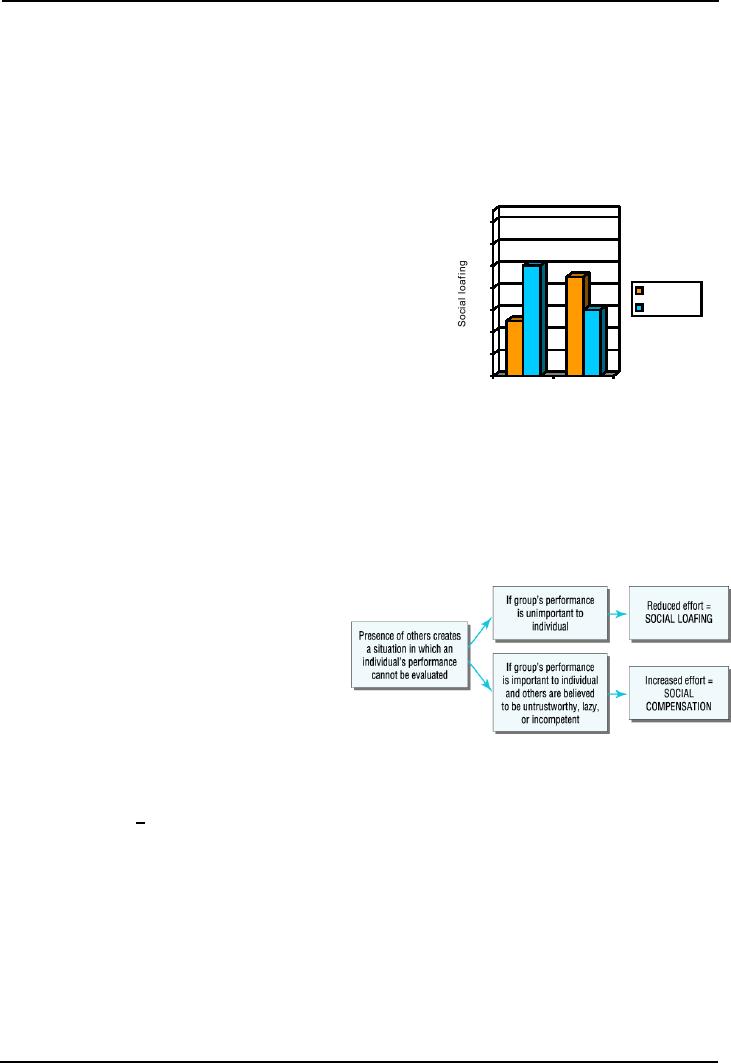 |

Social
Psychology (PSY403)
VU
Lesson
40
GROUP
BEHAVIOR
(CONTINUE............)
Aims
To
introduce the psychological effects of
being in a group and of interacting
with others on an
inter-
individual
level
Objectives
�
To
introduce the concept of social loafing
and discuss classic and
contemporary research
�
To
discuss the concept of
deindividuation
Social
Loafing
What
is social loafing?
�Group-induced reduction in
individual output when
performers' efforts are
pooled and so cannot be
individually
judged. When an individual's contribution
to a collective activity (pooled) cannot
be
evaluated,
individuals often work
less
hard
than they would
alone.
�Occurs when our
efforts are lost in the
crowd
�Group induced reduction in
individual output is known as
social loafing
�Social facilitation occurs
when individual output in a
group can be assessed
Early
& contemporary research
Max
Ringleman (1913) conducted
first empirical study:
efforts to pull a rope or
pushing a cart were less
when
people worked in a
group
Latane
(1979)
�Six
blindfolded participants in a
semicircle
�Earphones
with shouting voices being
played
�Told
to shout as loud as possible
�Told
they were shouting with one
other person vs. with 5
others, while actually
always just them
shouting
�Social
loafing occurs behaviourally and
cognitively
�Occurs
due to a diffusion of
responsibility
�Bystanders
fail to aid victims when
there are more
people
Percentage
intensity of shouting
�Occurs
in both individualistic and
collectivistic
alone
or in a group
cultures,
Figure
1 indicates that social loafing
occurs when in
100
group.
90
Task
complexity & social
loafing
Jackson
& Williams (1985):
80
�
So
far all the activities we
talked about were
simple.
But if evaluation apprehension is the
key
70
to
social loafing, then working
together will
lower
the evaluation apprehension
60
�
Task
was working on a complex computer
maze
alongside
a co-worker
50
Told
shouting with
Told
shouting in
�
Task
outcome responsibility is diffused
among
one
other person
group
fellow
co-actors; evaluation apprehension is
decreased
�
Told
that they would be
individually vs. collectively
evaluated
�
Participants
showed better performance when
collectively evaluated
169

Social
Psychology (PSY403)
VU
�
With
complex tasks the diffusion of
responsibility allows less
evaluation-apprehension so easier
to
attend
to the task
�
On
poorly learned tasks, less
evaluation apprehension and presumably arousal allows
more careful
concentration
on the task at hand, and thus an
increase in performance
Figure
2 shows social loafing as a
function of task
Social
loafing as a function of
task
complexity.
complexity
Processes
leading to social loafing
versus social
compensation
�
Karau
& Williams (1993) maintained
that:
14
o
Social
loafing depends on how
important the
12
person
believes his/her contribution is
to
10
group
success, and how much the
person
8
Individual
values
group success.
Collective
6
o
Social
compensation occurs
when a person
4
expends
great effort to compensate for
others
in
the group, and when others
are performing
2
inadequately,
and the person cares about
the
0
Simple
Complex
quality
of the group product
The
relationship between social compensation and
social
loafing
is shown below in Figure
3:
Reducing
Social Loafing
Processes
leading to social loafing
versus social
�
Make
each person's
contribution
identifiable
compensa
tion Karau & Williams
(1993)
o
People
were led to believe
that
their
performance
(shouting)
was identifiable or
never
identifiable (Williams
et
al., 1981)
�
Provide
them with a standard to
evaluate
their own or
group's
performance.
o
Provide
rewards for high
group
productivity
�
Make
task meaningful, complex,
or
interesting:
On challenging
tasks
people
may perceive their efforts
as
indispensable
o
Social
ostracism: Lazy workers are
socially rejected until they
conform to the group
productivity
norm.
o
Gender
differences have been reported by
Williams & Sommer (1997):
males coped by
redirecting
their interest to non-tasks in their
surroundings, while females
when were given
a
chance to get back into the good
graces of the group, they
worked hard to do so.
Social
loafing across cultures
�Social loafing has
been found in India,
Thailand, Japan, &
China
�However, social loafing
may be greater among people from the
U.S. than among Asians; 17
studies
showed
these results (Karau &
Williams, 1993).
170

Social
Psychology (PSY403)
VU
�In summary: Whether social facilitation
or social loafing occurs depends
on:
�Whether individuals are
identifiable
�Task complexity
�How much participants
care about the outcome
�Loyalty to family and
work groups in collectivistic
cultures.
�Gender:
women showed less social
loafing as they are considered
less individualistic.
Deindividuation
�Research indicates that groups
can arouse us, and can
lower evaluation apprehension. In
such
circumstances
our normal inhibitions may
diminish and we may engage in
behaviors we normally
avoid.
�May occur in crowded, anonymous
situations when people lose
a sense of responsibility for
their own
actions
and feel free to express
aggressive and sexual impulses.
�Prentice-Dunn and Rogers
(1980) believe that
accountability cues, such as
anonymity, tell people how
far
they
can go without being held
responsible for their actions.
�These cues loosen restraint
against deviant behavior by altering a
person's cost-reward calculations, e.g.,
during
a riot people often believe
that they would not be
caught.
Situational
factors leading to deindividuation
Deindividuation
is an internal state that
involves lowered self
observation and evaluation.
Once
it occurs it results in intense
behaviors, which are not
under stimulus control,
difficult to terminate,
and
are self reinforcing. Once
inhibitions are gone, people
impulsively engage in antisocial
behavior, like
vandalism,
aggression, and rioting.
�According to Zimbardo
(1970), following are the factors
leading to deindividuation:
�Group size
�Stimulus overload
�Altered states of
consciousness
�Anonymity
�Arousal
�Noncognitive
interactions
�Diffusion of
responsibility
�Zimbardo (1970) had groups of
four young women delivering
electric shocks to another person:
Groups were either easily
identifiable or not
Unidentifiable groups gave twice as
many shocks
Internet-induced
deindividuation:
Christina Demetriou and
Andrew Silke (2003) established a
web site to determine whether
people who
visited
to gain access to legal
material will also try to
gain access to illegal and
pornographic material
when
they
discovered it was available (not
available actually). Over a
three-month period, a majority of
more
than
800 visitors tried to get an
access to the illegal material.
The researchers concluded
that "Virtual"
groups
created on Internet
sites:
have the capacity to
induce deindividuation, OR
might heighten
individual's identification with the
group and increase
conformity
Figure
4 shows effects of deindividuation on
stealing (Diener, 1980).
Children were asked to take
only one
candy;
while hidden observers recorded
how many the children
actually took when alone and
when in
group.
171

Social
Psychology (PSY403)
VU
Figure
4:
Explanations
of deindividuation
�Deindividuation increases
when individuals
60
are
anonymous and as group size
increases.
�
Diener (1980)
indicates that the crucial
50
cognitive
factor in deindividuation is a lack
of
self
awareness. Deindividuation might
create
40
a
special psychological state in which
people
are
focused externally and unaware of
own
Identified
30
values.
People do not attend to their
own
A
nonymous
inner
values and standards. When people
fail
20
to
take themselves as an object of
attention,
they
abdicate their personal standards
of
10
conduct
and fall prey to the influence
of
immediate
situation.
0
�Not a loss of personal
identity, but
A
lone
In
a group
deindividuation
setting facilitates a
transition
from
a personal to a more social identity.
People
are simply conforming to the
prevailing group
norm.
Readings
�Franzoi, S. (2003).
Social
Psychology. Boston:
McGraw-Hill. Chapter 10
Other
Readings
�Lord, C.G. (1997).
Social
Psychology. Orlando:
Harcourt Brace and Company. Chapter
8.
�David G. Myers, D. G.
(2002). Social
Psychology (7th ed.).
New York: McGraw-Hill.
�Taylor, S.E. (2006).
Social Psychology (12th ed.).
New York: Prentice
Hall.
172
Table of Contents:
- INTRODUCTION TO SOCIAL PSYCHOLOGY:Readings, Main Elements of Definitions
- INTRODUCTION TO SOCIAL PSYCHOLOGY:Social Psychology and Sociology
- CONDUCTING RESEARCH IN SOCIAL PSYCHOLOGY:Scientific Method
- CONDUCTING RESEARCH IN SOCIAL PSYCHOLOGY:Evaluate Ethics
- CONDUCTING RESEARCH IN SOCIAL PSYCHOLOGY RESEARCH PROCESS, DESIGNS AND METHODS (CONTINUED)
- CONDUCTING RESEARCH IN SOCIAL PSYCHOLOGY OBSERVATIONAL METHOD
- CONDUCTING RESEARCH IN SOCIAL PSYCHOLOGY CORRELATIONAL METHOD:
- CONDUCTING RESEARCH IN SOCIAL PSYCHOLOGY EXPERIMENTAL METHOD
- THE SELF:Meta Analysis, THE INTERNET, BRAIN-IMAGING TECHNIQUES
- THE SELF (CONTINUED):Development of Self awareness, SELF REGULATION
- THE SELF (CONTINUE…….):Journal Activity, POSSIBLE HISTORICAL EFFECTS
- THE SELF (CONTINUE……….):SELF-SCHEMAS, SELF-COMPLEXITY
- PERSON PERCEPTION:Impression Formation, Facial Expressions
- PERSON PERCEPTION (CONTINUE…..):GENDER SOCIALIZATION, Integrating Impressions
- PERSON PERCEPTION: WHEN PERSON PERCEPTION IS MOST CHALLENGING
- ATTRIBUTION:The locus of causality, Stability & Controllability
- ATTRIBUTION ERRORS:Biases in Attribution, Cultural differences
- SOCIAL COGNITION:We are categorizing creatures, Developing Schemas
- SOCIAL COGNITION (CONTINUE…….):Counterfactual Thinking, Confirmation bias
- ATTITUDES:Affective component, Behavioral component, Cognitive component
- ATTITUDE FORMATION:Classical conditioning, Subliminal conditioning
- ATTITUDE AND BEHAVIOR:Theory of planned behavior, Attitude strength
- ATTITUDE CHANGE:Factors affecting dissonance, Likeability
- ATTITUDE CHANGE (CONTINUE……….):Attitudinal Inoculation, Audience Variables
- PREJUDICE AND DISCRIMINATION:Activity on Cognitive Dissonance, Categorization
- PREJUDICE AND DISCRIMINATION (CONTINUE……….):Religion, Stereotype threat
- REDUCING PREJUDICE AND DISCRIMINATION:The contact hypothesis
- INTERPERSONAL ATTRACTION:Reasons for affiliation, Theory of Social exchange
- INTERPERSONAL ATTRACTION (CONTINUE……..):Physical attractiveness
- INTIMATE RELATIONSHIPS:Applied Social Psychology Lab
- SOCIAL INFLUENCE:Attachment styles & Friendship, SOCIAL INTERACTIONS
- SOCIAL INFLUENCE (CONTINE………):Normative influence, Informational influence
- SOCIAL INFLUENCE (CONTINUE……):Crimes of Obedience, Predictions
- AGGRESSION:Identifying Aggression, Instrumental aggression
- AGGRESSION (CONTINUE……):The Cognitive-Neo-associationist Model
- REDUCING AGGRESSION:Punishment, Incompatible response strategy
- PROSOCIAL BEHAVIOR:Types of Helping, Reciprocal helping, Norm of responsibility
- PROSOCIAL BEHAVIOR (CONTINUE………):Bystander Intervention, Diffusion of responsibility
- GROUP BEHAVIOR:Applied Social Psychology Lab, Basic Features of Groups
- GROUP BEHAVIOR (CONTINUE…………):Social Loafing, Deindividuation
- up Decision GROUP BEHAVIOR (CONTINUE……….):GroProcess, Group Polarization
- INTERPERSONAL POWER: LEADERSHIP, The Situational Perspective, Information power
- SOCIAL PSYCHOLOGY APPLIED: SOCIAL PSYCHOLOGY IN COURT
- SOCIAL PSYCHOLOGY APPLIED: SOCIAL PSYCHOLOGY IN CLINIC
- FINAL REVIEW:Social Psychology and related fields, History, Social cognition